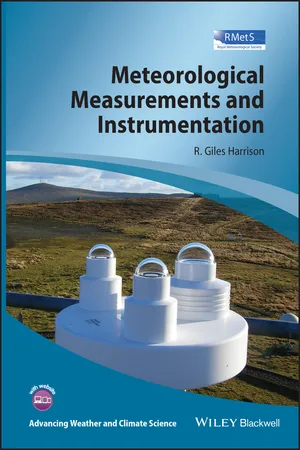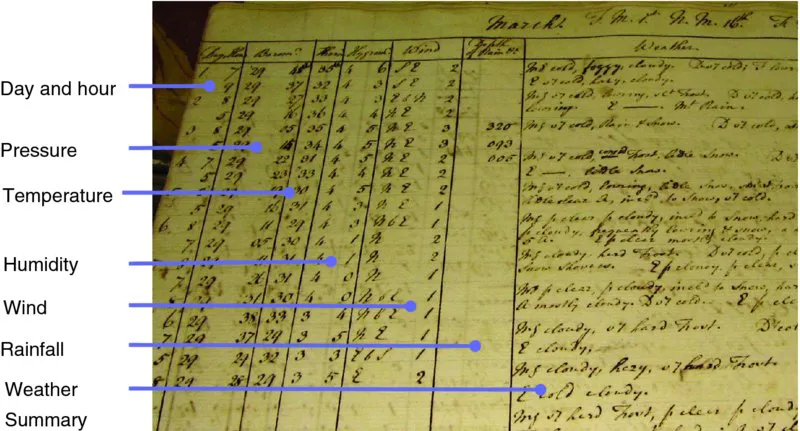
- English
- ePUB (mobile friendly)
- Available on iOS & Android
eBook - ePub
Meteorological Measurements and Instrumentation
About this book
This book describes the fundamental scientific principles underlying high quality instrumentation used for environmental measurements. It discusses a wide range of in situ sensors employed in practical environmental monitoring and, in particular, those used in surface based measurement systems. It also considers the use of weather balloons to provide a wealth of upper atmosphere data. To illustrate the technologies in use it includes many examples of real atmospheric measurements in typical and unusual circumstances, with a discussion of the electronic signal conditioning, data acquisition considerations and data processing principles necessary for reliable measurements. This also allows the long history of atmospheric measurements to be placed in the context of the requirements of modern climate science, by building the physical science appreciation of the instrumental record and looking forward to new and emerging sensor and recording technologies.
Frequently asked questions
Yes, you can cancel anytime from the Subscription tab in your account settings on the Perlego website. Your subscription will stay active until the end of your current billing period. Learn how to cancel your subscription.
At the moment all of our mobile-responsive ePub books are available to download via the app. Most of our PDFs are also available to download and we're working on making the final remaining ones downloadable now. Learn more here.
Perlego offers two plans: Essential and Complete
- Essential is ideal for learners and professionals who enjoy exploring a wide range of subjects. Access the Essential Library with 800,000+ trusted titles and best-sellers across business, personal growth, and the humanities. Includes unlimited reading time and Standard Read Aloud voice.
- Complete: Perfect for advanced learners and researchers needing full, unrestricted access. Unlock 1.4M+ books across hundreds of subjects, including academic and specialized titles. The Complete Plan also includes advanced features like Premium Read Aloud and Research Assistant.
We are an online textbook subscription service, where you can get access to an entire online library for less than the price of a single book per month. With over 1 million books across 1000+ topics, we’ve got you covered! Learn more here.
Look out for the read-aloud symbol on your next book to see if you can listen to it. The read-aloud tool reads text aloud for you, highlighting the text as it is being read. You can pause it, speed it up and slow it down. Learn more here.
Yes! You can use the Perlego app on both iOS or Android devices to read anytime, anywhere — even offline. Perfect for commutes or when you’re on the go.
Please note we cannot support devices running on iOS 13 and Android 7 or earlier. Learn more about using the app.
Please note we cannot support devices running on iOS 13 and Android 7 or earlier. Learn more about using the app.
Yes, you can access Meteorological Measurements and Instrumentation by R. Giles Harrison,Giles Harrison in PDF and/or ePUB format, as well as other popular books in Physical Sciences & Meteorology & Climatology. We have over one million books available in our catalogue for you to explore.
Information
1
Introduction
The appearance of the sky and its relationship to the atmosphere's properties have, no doubt, always provoked curiosity, with early ideas on explaining its variations available from Aristotle. A defining change in the philosophy of atmospheric studies occurred in the seventeenth century, however, with the beginning of quantitative measurements, and the dawn of the instrumental age. Since then, elaborate devices to monitor and record changes in the elements have continued to develop, providing, along the way, measurements underpinning the instrumental record of past environmental changes, most notably in air temperature. This means that characterising and understanding early meteorological instruments are of much more than solely historical interest, as recovering past measurements, whilst recognising their limitations, can also have immediate geophysical relevance.
An important meteorological example is the reconstruction of past temperature variations from the miscellaneous thermometer records originally undertaken to satisfy personal curiosity. Ships' logbooks provide another example, in terms of geomagnetic field changes. Beyond the actual data produced in either case, this also provides a reminder that all measurements can have unforeseen applications well beyond their original motivation [1], either through a change of context in which the measurements are evaluated, or because other subsequently important information has unwittingly been included.1 Such future scope is probably impossible to predict completely, but it can to some extent be allowed for by ensuring a full appreciation of the related measurement science through careful description of the construction, calibration and recording procedures for the instrumentation employed. The possible future legacy implied by taking this historical perspective adds further motivation for rigour in the modern science of atmospheric measurement.
This chapter briefly highlights some of the major historical landmarks in development of instrumentation science for meteorology, and concludes with an overview of the book's material.
1.1 The instrumental age
Many of the early atmospheric measuring instruments were developed in Florence, due perhaps in part to the experimental physical science tradition inspired by Galileo, and availability of the necessary craftsmanship. This included early thermometers, such as the thermoscope produced during the late 1500s to determine changes in temperature. Following key instrument advances such as the invention of the barometer by Evangelista Torricelli in 1643 and an awareness of the need for standardisation of thermometers, modern quantitative study of the atmosphere can be considered to date from the mid-seventeenth century.
Early measurement networks followed from the availability of measuring technologies combined with the formation of learned scientific societies, which together provided the means to record and exchange information in a published form. Comparison of measurements required a system of standardisation, such as that achieved through common instrumentation, and in many cases, common exposure. For thermometers, an agreed temperature scale was necessary and the Celsius,2 Fahrenheit3 or Réaumur4 scales all originated in the eighteenth century [2]. The meteorological values were published as tables of readings, in many cases without any further processing, but which were sufficiently complete for analysis to be made later.
1.2 Measurements and the climate record
Early weather records can be found in ‘weather diaries’, which were usually kept by well-educated and well-resourced individuals able to purchase or construct scientific instruments such as barometers and thermometers. In some cases, these diaries contain considerable descriptive and quantitative geophysical data, such as those of temperature and rainfall measurements (Figure 1.1).

Figure 1.1 Example page from a weather diary (kept by an apothecary and surgeon, Thomas Hughes at Stroud, Gloucestershire, between 1771 and 1813), in which daily measurements of air pressure, temperature, humidity, rainfall and weather were recorded. As well as quantitative weather information, this particular diary includes other geophysical information, such as timings of earthquakes and even occurrence of the aurora borealis, an indirect measure of solar activity [3]. (Reproduced from Reference 3 with permission of The Met Office.)
Such early data sources are important because of the reference information they provide for the study of climate change, and they therefore remain of scientific value many centuries later. This is particularly true of the disparate thermometer measurements made in southern England from the 1600s, which, although made originally by individuals in an uncoordinated way, now provide an important climate data resource. The temperature readings were cross-checked and compiled5 in the 1950s, drawing on knowledge of the different instruments used and understanding of their exposures [4]. This important synthesis generated a long series of temperature data for an area conveniently described as ‘Central England’, amounting to an approximately triangular region bounded by Bristol, Manchester and London.
The Central England measurements form the longest continuous set of monthly instrumental atmospheric temperatures available anywhere in the wo...
Table of contents
- Cover
- Series
- Title Page
- Copyright
- Series Foreword
- Preface
- Acknowledgements
- Disclaimer
- Chapter 1: Introduction
- Chapter 2: Principles of Measurement and Instrumentation
- Chapter 3: Electronics and Analogue Signal Processing
- Chapter 4: Data Acquisition Systems and Initial Data Analysis
- Chapter 5: Temperature
- Chapter 6: Humidity
- Chapter 7: Atmospheric Pressure
- Chapter 8: Wind Speed and Direction
- Chapter 9: Radiation
- Chapter 10: Clouds, Precipitation and Atmospheric Electricity
- Chapter 11: Upper Air Instruments
- Chapter 12: Further Methods for Environmental Data Analysis
- Appendix A: Writing a Brief Instrumentation Paper
- Appendix B: Anemometer Coordinate Rotations
- References
- Index
- End User License Agreement